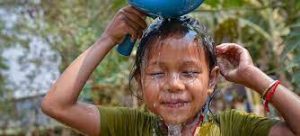Impact Of Heatwaves On Children: UNICEF

UNICEF (United Nations Children’s Fund) released a report titled “Coldest Year of the Rest of Their Lives – Protecting children from the escalating impacts of heatwaves”, showing that nearly all the children across the world will be exposed to more frequent and severe heat waves by 2050.
Findings of the UNICEF Report:
- Around 559 million children are exposed to high heatwave frequency and around 624 million children are exposed to one of three other high heat measures – High heatwave duration, High heatwave severity and Extreme high temperatures.
- One in four children lives in areas where the average heatwave event lasts 4.7 days or longer as of 2020.
- This percentage will rise to over three in four children under a low-emission scenario by 2050.
- Children in southern, western and south-eastern Asia, eastern and southern Europe and northern Africa experience heatwaves of longer duration.
- The number of children exposed to high heat waves will quadruple to over two billion by 2050 — up from 24% of children in 2020.
- This amounts to an increase of about 1.5 billion children.
- Virtually every child on earth will face severe heat waves even under a low greenhouse gas emission scenario — with an estimated 1.7°C of warming in 2050.
- At 2.4 degrees of warming, 94% of children will be exposed with only small areas of southern America, central Africa, Australasia and Asia not exposed to high heatwave duration.
- Heat Waves with longer duration pose more risks for children as they spend more time outdoors than adults for — sports and other activities putting them at greater risk for heat injury.
- High temperatures are linked to increased mental health problems in children and adolescents, including post-traumatic stress disorder (PTSD) and depression.
- Extreme heat will essentially affect children’s education and future livelihoods.
- Heatwave risks to health include heat stroke, heat stress, allergy, chronic respiratory conditions, asthma, mosquito-borne disease, cardiovascular disease, undernutrition and diarrhoea.
- Communities are forced to search for and compete over food and water resources as pastures and household income dry up. The resulting migration, displacement and conflict expose children to serious physical harm and violence risks.




